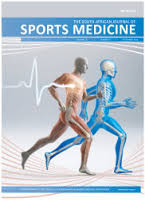The use of negative pressure wave treatment in athlete recovery
DOI:
https://doi.org/10.17159/2078-516X/2017/v29i1a2929Abstract
Background: Athletes need to recover fully to maximise performance in competitive sport. Athletes who replenish more quickly and more efficiently are able to train harder and more intensely. Elite athletes subjectively report positive results using lower body negative pressure (LBNP) treatment as an alternate method for rapid recovery, restoring and improving their impaired physical state. Objective data on the efficacy are lacking.
Objectives: To investigate the effect of intermittent vacuum therapy on accelerating acute recovery following an athlete’s normal daily training schedule of strenuous exercise. Objective measurements of biological markers of muscular fatigue were used to assess recovery.
Methods: Twenty-two male cricket players in a randomised cross-over study were divided into a treatment and control group respectively. Following a one-hour high-intensity gym session, the treatment group received three 30-minute LBNP exposure sessions over three consecutive days (0, 24 and 48 hours). Blood lactate and creatine kinase biomarkers were collected to measure the recovery process. After 14 days groups were crossed over and the trial repeated.
Results: Heart rate and blood pressure decreased noticeably during treatment, reverting to baseline levels after treatment. Lactate concentrations decreased in both groups after exercise termination; significantly more in the treatment (0.57±0.23 mmol/l) than control group (0.78±0.22 mmol/l), p<0.001). Creatine kinase (CK) was similar in both groups. Athletes’ subjective assessments of recovery rated moderately high.
Conclusion: LBNP therapy applied as treatment during routine schedule may have a systemic effect in lowering serum lactate levels, but not CK levels. Enhanced recovery of athletes is still unconfirmed.
Downloads
Downloads
Published
Issue
Section
License
Copyright (c) 2017 South African Journal of Sports Medicine

This work is licensed under a Creative Commons Attribution 4.0 International License.
The South African Journal of Sports Medicine reserves copyright of the material published. The work is licensed under a Creative Commons Attribution 4.0 (CC BY 4.0) International License. Material submitted for publication in the South African Journal of Sports Medicine is accepted provided it has not been published elsewhere. The South African Journal of Sports Medicine does not hold itself responsible for statements made by the authors.
How to Cite
- Abstract 394
- PDF 626






.png)